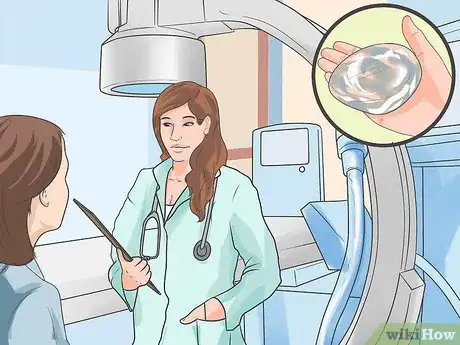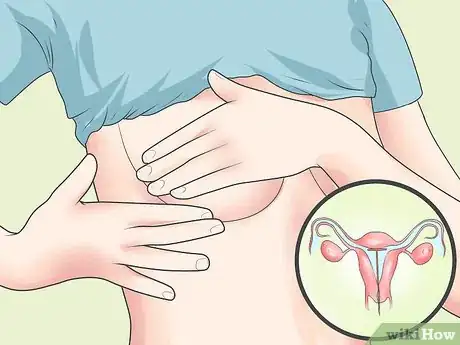This article was medically reviewed by Lacy Windham, MD. Lacy Windham, MD, is a Board-Certified Obstetrician & Gynecologist in Cleveland, Tennessee. Dr. Windham attended medical school at the University of Tennessee Health Science Center in Memphis. Her residency was completed at Eastern Virginia Medical School in Norfolk, Virginia. She was the recipient of multiple awards during her residency training, including Most Outstanding Resident in Maternal Fetal Medicine, Most Outstanding Resident in Oncology, Most Outstanding Resident Overall, and Special Award in Minimally Invasive Surgery.
There are 16 references cited in this article, which can be found at the bottom of the page.
wikiHow marks an article as reader-approved once it receives enough positive feedback. In this case, 100% of readers who voted found the article helpful, earning it our reader-approved status.
This article has been viewed 149,724 times.
Experts agree mammograms can help catch breast cancer early so you have a better chance of recovering. During a mammogram, your healthcare provider will take X-ray images of your breasts to check for signs of breast cancer.[1] Researchers say that a screening mammogram may help identify changes in your breast tissue, while a diagnostic mammogram can help your doctor evaluate changes in your breast.[2] You may experience discomfort during a mammogram, but try not to worry; it's typically a very quick procedure.
Steps
Making an Informed Decision
-
1Visit a doctor before your mammogram. While it may not be required, it is still recommended to see a physician for a clinical breast exam prior to the mammogram. Mammograms will miss 10% of breast cancers that can be detected clinically.[3]
- Many mammogram facilities will allow a woman over the age of 40 to make an appointment without a referral or prescription from their doctor.[4]
- Talk with the doctor about any breast symptoms or signs, like breast tenderness, nipple discharge, or new lumps found on self-examination; inform her of any hormone use. Tell the doctor about your medical history, specifically any personal and family history of breast cancer.[5] Then, the doctor will perform a breast exam and look for any abnormalities.
- Follow the doctor’s advice about what signs, symptoms, and medical history are best to share with the radiology technologist who will take the X-rays on the day of the mammogram.
- Have the doctor address any questions or concerns you may have about your upcoming study.
-
2Choose a mammography facility approved by the FDA. The Food and Drug Administration ensures the facility meets specific baseline quality standards for equipment, personnel, and practices.[6]
- Do an internet search to find a facility near you. There is a Mammography Facility Database on the FDA website.[7] You can call a local medical clinic or your health department for suggestions.
Advertisement -
3Find a mammogram facility that has experience with breast implants. Women with breast implants can and should get regular mammograms. Breasts implants can obscure breast tissue and interfere with the visualization of abnormalities and delay the diagnosis of breast cancer.[8]
- The technologist most likely will take additional X-rays to maximize visualization of all breast tissue. He may try to manipulate the implant to move it away from the breast tissue.[9]
- Capsular contractures or scar tissue around breast implants can make breast compression by the machine too painful or impossible. There is a risk of rupture. Let the technologist know if you are having too much pain.[10]
Taking the Stress out of Mammography
-
1Schedule your mammogram around your menstrual period. The mammogram involves having your breast gradually compressed. A woman’s breasts become tender before and during her menstrual period. If you are premenopausal, still menstruating, it is best to have the study in the week after your menstrual period ends.[11]
-
2Obtain copies of any previous mammograms. You will take these films with you to the appointment. It is your responsibility to make sure the copies are at the facility on the day of your appointment.[12]
- The X-ray images of your breast will be analyzed by a certified radiologist. This type of doctor is trained to evaluate X-rays like mammograms and to suggest a diagnosis based upon what he sees on the films. She compares your current films to your old films, looking for any new abnormalities or if a previous abnormality has changed in size or appearance. This comparison is an essential part of determining if anything seen on your mammogram is suggestive of breast cancer.[13]
- Give your old facility enough time to make copies of the X-ray films. Mammograms can be X-ray films or digital images sent directly to a computer workstation.[14] It is possible for digital images to be sent electronically, but you will need to ask.
- If your previous mammograms were performed at the same facility, just let the radiology technologist know on the day of the appointment. She will inform the radiologist.
-
3Avoid caffeine-containing foods and beverages like coffee, tea, and energy drinks. Caffeine can cause breast tenderness. Consider abstaining for several days up to 2 weeks before your appointment.[15]
-
4Take an over-the-counter pain reliever one hour before the procedure. Compression of your breasts during the mammogram is necessary, but it can be painful. Take steps to minimize the discomfort you experience.
- Fear of pain or anxiety about the procedure should not be a reason to not have a mammogram performed. If your anxiety is great, your doctor may administer an anti-anxiety medication prior to the exam.
- You can take a medication like acetaminophen (Tylenol), ibuprofen (Motrin, Advil), or aspirin to try to ease any discomfort. Do not take any medications without first consulting your doctor.
- You can take a pain reliever after the study as well. If you take medication before the study, make sure the suggested time has elapsed before repeating the next dosing.
- Compression of the breast tissue is not harmful. There are advantages to having the tissue spread out evenly. It allows better visualization of any abnormalities. The superior tissue penetration allows for less radiation use. Blurring of the images is decreased because the tissue is being held in place.[16]
-
5Do not apply any grooming products under the arms or on the breasts. Products, such as deodorants, antiperspirants, powders, lotions, creams, or perfumes can interfere with the quality of the X-ray images.[17]
- Grooming products can have metallic particles or contain calcium, resulting in shadows on the X-ray. This could be mistaken for or hide abnormal breast tissue. Avoid undergoing additional testing or possibly losing the opportunity to have a breast cancer detected early.
-
6Wear a shirt with pants, shorts, or a skirt. You will need to undress from the waist up and put on a gown that opens in the front. Changing your clothing will be easier if you only have to remove your shirt.[18]
-
7Leave any neck jewelry at home. Anything around the neck will interfere with obtaining clear X-ray images of your breasts. [19] Do not risk having neck jewelry lost or stolen because you have to remove it.
-
8Bring your ID and insurance information. You must check in before the mammogram is performed. The process involves confirming your identity and your insurance information. You will sign some papers, as well.
- Ask at what time and where in the facility you are expected. Plan your travel time so that you arrive early.
-
9Tell the radiology technologist about your breast-related medical history. The American Cancer Society (ACS) recommends sharing your personal or family history of breast cancer and any breast signs and symptoms, like lumps or breast discharge. Consider previous mammograms to be a part of this history.[20]
- The technologist can focus on any suspicious areas and communicate that to the radiologist if you tell him about specific breast signs and symptoms. The technologist also will pass on any information about your personal or family history of breast cancer.
-
10Tell the radiology technologist about any physical limitations. The mammogram will take about 30 minutes. You will need to stand and change positions during this time. The technologist will work around any physical limitations.
- You will stand in front of the X- ray machine. The technologist will place the breast on a platform which is raised or lowered to match your height. Proper positioning of your arms, torso, and head is key to obtaining high-quality X-ray images. Finally, a clear plastic plate will gradually compress the breast. Once the breast is properly compressed, you will need to stand still and hold your breath. This process will be repeated on the other breast.[21]
References
- ↑ https://www.cdc.gov/cancer/breast/basic_info/mammograms.htm
- ↑ https://www.cancer.org/cancer/breast-cancer/screening-tests-and-early-detection/mammograms/mammogram-basics.html
- ↑ http://www.cancer.gov/types/breast/mammograms-fact-sheet
- ↑ http://www.imaginis.com/mammography/frequently-asked-questions-about-mammography-and-breast-cancer-3
- ↑ http://www.wakemed.org/body.cfm?id=1028
- ↑ http://womenshealth.gov/publications/our-publications/fact-sheet/mammograms.html#j
- ↑ http://www.accessdata.fda.gov/scripts/cdrh/cfdocs/cfMQSA/mqsa.cfm
- ↑ https://www.cancer.org/cancer/breast-cancer/screening-tests-and-early-detection/mammograms/mammograms-for-women-with-breast-implants.html
- ↑ http://womenshealth.gov/publications/our-publications/fact-sheet/mammograms.html#j
- ↑ http://www.stopcancerfund.org/uncategorized/breast-implants-and-mammography-what-we-know-and-what-we-dont-know/
- ↑ https://www.cdc.gov/cancer/breast/basic_info/mammograms.htm
- ↑ http://womenshealth.gov/publications/our-publications/fact-sheet/mammograms.html#j
- ↑ http://www.wakemed.org/body.cfm?id=1028
- ↑ http://www.imaginis.com/mammography/frequently-asked-questions-about-mammography-and-breast-cancer-3
- ↑ http://cancer.about.com/od/mammograms/tp/painmammogram.htm
- ↑ http://www.wakemed.org/body.cfm?id=1028
- ↑ https://www.cdc.gov/cancer/breast/basic_info/mammograms.htm
- ↑ http://womenshealth.gov/publications/our-publications/fact-sheet/mammograms.html#j
- ↑ http://womenshealth.gov/publications/our-publications/fact-sheet/mammograms.html#j
- ↑ http://www.wakemed.org/body.cfm?id=1028
- ↑ http://www.wakemed.org/body.cfm?id=1028
- ↑ https://www.hopkinsmedicine.org/health/treatment-tests-and-therapies/mammogram-procedure
- ↑ https://www.breastcancer.org/managing-life/fertility-pregnancy-issues/diagnosed-during-pregnancy/screening
- ↑ http://www.cancer.org/cancer/breastcancer/moreinformation/pregnancy-and-breast-cancer











































































Medical Disclaimer
The content of this article is not intended to be a substitute for professional medical advice, examination, diagnosis, or treatment. You should always contact your doctor or other qualified healthcare professional before starting, changing, or stopping any kind of health treatment.
Read More...